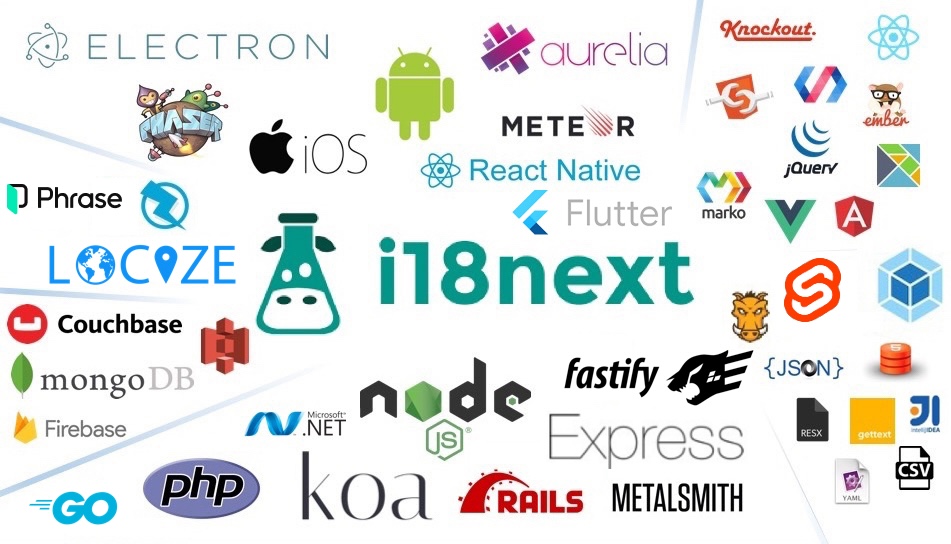Integration
- i18next:
i18next can be integrated into various JavaScript frameworks and environments, including React, Vue, Angular, and Node.js. Its flexibility allows developers to use it in both front-end and back-end applications, making it a universal solution for internationalization.
- react-i18next:
react-i18next is tailored for React applications, offering hooks and higher-order components that align with React's component model. This makes it easy to manage translations within React components and utilize React's state management effectively.
- react-intl:
react-intl is built for React and focuses on providing internationalization support through components and APIs. It integrates well with React's ecosystem, allowing developers to format messages and handle localization directly within their components.
- next-translate:
next-translate is specifically designed for Next.js applications, providing a seamless integration experience. It leverages Next.js features like static generation and server-side rendering, making it a great choice for developers already using the Next.js framework.
Feature Set
- i18next:
i18next boasts a comprehensive feature set, including support for pluralization, context-based translations, interpolation, and fallback languages. It also offers advanced features like language detection and caching, making it suitable for complex applications that require robust internationalization capabilities.
- react-i18next:
react-i18next provides a rich set of features specifically for React, including hooks for managing translations, lazy loading of translation files, and support for context-based translations. It allows for a more dynamic and responsive user experience in React applications.
- react-intl:
react-intl focuses on message formatting and localization, providing features like pluralization, date and time formatting, and number formatting. It is particularly useful for applications that require precise control over how localized content is presented.
- next-translate:
next-translate offers a simplified feature set focused on file-based translations and automatic code-splitting. It provides a straightforward approach to managing translations in Next.js applications, making it easy to implement without overwhelming complexity.
Learning Curve
- i18next:
i18next has a moderate learning curve due to its extensive feature set and flexibility. Developers may need to invest time in understanding its configuration and advanced features, but its documentation is comprehensive and helpful.
- react-i18next:
react-i18next is designed to be intuitive for React developers, leveraging familiar concepts like hooks and components. The learning curve is gentle, especially for those already accustomed to React's paradigms.
- react-intl:
react-intl has a moderate learning curve, particularly for developers who need to understand message formatting and localization concepts. However, its API is well-documented, which aids in the learning process.
- next-translate:
next-translate is relatively easy to learn, especially for developers familiar with Next.js. Its straightforward approach to translations and integration with Next.js makes it accessible for those new to internationalization.
Performance
- i18next:
i18next is optimized for performance, allowing for lazy loading of translation files and caching strategies to minimize load times. This is particularly beneficial for applications with large translation files or multiple languages.
- react-i18next:
react-i18next is designed for performance in React applications, supporting lazy loading and efficient re-rendering of components when translations change. This helps maintain a smooth user experience even in dynamic applications.
- react-intl:
react-intl focuses on efficient message formatting and rendering, ensuring that localized content is displayed quickly and accurately. Its performance is generally good, but it may require careful management of message definitions to avoid unnecessary re-renders.
- next-translate:
next-translate enhances performance by automatically code-splitting translation files based on the routes in a Next.js application. This ensures that only the necessary translations are loaded, improving initial load times.
Community and Support
- i18next:
i18next has a large and active community, providing extensive documentation, tutorials, and support channels. This makes it easier for developers to find help and resources when implementing internationalization in their applications.
- react-i18next:
react-i18next enjoys strong community support within the React ecosystem. Its documentation is comprehensive, and there are numerous tutorials and examples available to assist developers in implementing internationalization effectively.
- react-intl:
react-intl is part of the FormatJS project, which has a dedicated community and good documentation. While it may not be as widely used as i18next, it still offers solid support and resources for developers.
- next-translate:
next-translate has a growing community, particularly among Next.js developers. While its community is smaller compared to i18next, it benefits from the support of the Next.js ecosystem and its documentation is clear and concise.




















